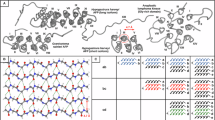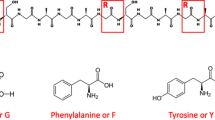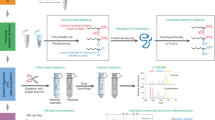Abstract
Hydrogen exchange measurements on equine lysozyme show that amides in three of the four major helices of the native protein are significantly protected in a molten globule state formed at pH 2. The pattern of protection within the different helices, however, varies significantly. Examination of the pattern in the light of the native structure indicates that the side chains of the protected residues form a compact cluster within the core of the protein. We suggest that such a core is present in the molten globule state, indicating the existence of substantial native-like interactions between hydrophobic residues. The formation of clusters of this type during the early stages of folding could be crucial to directing polypeptide chains to their native structures.
This is a preview of subscription content, access via your institution
Access options
Subscribe to this journal
Receive 12 print issues and online access
$259.00 per year
only $21.58 per issue
Buy this article
- Purchase on SpringerLink
- Instant access to full article PDF
Prices may be subject to local taxes which are calculated during checkout
Similar content being viewed by others
References
Ptitsyn, O.B. The molten globule state. in Protein Folding, (ed. Creighton, T.E.) 243–300 (Freeman, New York, 1992).
Kuwajima, K. The molten globule as a clue for understanding the folding and cooperativity of globular protein structures. Proteins Struct. Funct. Genet. 6, 87–103 (1989).
Baldwin, R.L. Pulsed H/D-exchange studies of folding intermediates. Curr. Opin. struct. Biol. 3, 84–91 (1993).
Haynie, D.T. & Freire, E. Structural energetics of the molten globule. Proteins Struct. Funct. Genet. 16, 115–140 (1993).
Dobson, C.M. Solid evidence for molten globules. Curr. Biol. 4, 636–640 (1994).
Wolynes, P.G., Onuchic, J.N. & Thirumalai, D. Navigating the folding routes. Science 267, 1619–1620 (1995).
Peng, Z.-y., Wu, L.C. & Kim, P.S. Local structural preferences in the α-lactalbumin molten globule. Biochemistry 34, 3248–3252 (1995).
Dobson, C.M. Unfolded proteins, compact states and molten globules. Curr. Opin. struct. Biol. 2, 6–12 (1992).
Baum, J., Dobson, C.M., Evans, P.A. & Hanley, C. Characterization of a partially folded protein by NMR methods: studies on the molten globule state of guinea pig α-lactalbumin. Biochemistry 28, 7–13 (1989).
Jeng, M.-f., Englander, S.W., Elöve, G.A., Wand, A.J. & Roder, H. Structural description of acid-denatured cytochrome c by hydrogen exchange and 2D NMR. Biochemistry 29, 10433–10437 (1990).
Hughson, F.M., Wright, P.E. & Baldwin, R.L. Structural characterisation of a partly folded apomyoglobin intermediate. Science 249, 1544–1548 (1990).
Chyan, C.-L., Wormald, C., Dobson, C.M., Evans, P.A. & Baum, J. Structure and stability of the molten globule state of guinea-pig α-lactalbumin: a hydrogen exchange study. Biochemistry 32, 5681–5691 (1993).
Morozova, L., Haezebrouck, P. & Van Cauwelaert, F. Stability of equine lysozyme. 1. Thermal unfolding behaviour. Biophys. Chem. 41, 185–191 (1991).
Van Dael, H., Haezebrouck, P., Morozova, L., Arico-Muendel, C. & Dobson, C.M. Partially folded states of equine lysozyme. Structural characterisation and significance for protein folding. Biochemistry 32, 11886–11894 (1993).
Radford, S.E., Dobson, C.M. & Evans, P.A. The folding of hen lysozyme: a complex process involving partially structured intermediates and multiple pathways. Nature 358, 302–307 (1992).
Hooke, S.D., Eyles, S.J., Miranker, A., Radford, S.E., Robinson, C.V. & Dobson, C.M. Co-operative elements in protein folding monitored by electrospray ionization mass spectroscopy. J. Amer. chem. Soc. 117, 7548–7549 (1995).
Hooke, S.D., Radford, S.E. & Dobson, C.M. The refolding of human lysozyme: a comparison with the structurally homologous hen lysozyme. Biochemistry 33, 5867–5876 (1994).
Rooman, M.J. & Wodak, S.J. Extracting information on folding from the amino acid sequence: Consensus regions with preferred conformation in homologous proteins. Biochemistry 31, 10239–10249 (1992).
Moult, J. & Unger, R. An analysis of protein folding pathways. Biochemistry 30, 3816–3824 (1991).
Chelvanayagam, G., Reich, Z., Bringas, R. & Argos, P. Prediction of protein folding pathways. J. molec. Biol. 227, 901–916 (1992).
Chan, H.S. & Dill, K.A. Polymer principles in protein structure and stability. A. Rev. Biophys. biophys. Chem. 20, 447–490 (1991).
Evans, P.A., Topping, K.D., Woolfson, D.N., Dobson, C.M. Hydrophobic clustering in non-native states of a protein: interpretation of chemical shifts in NMR spectra of denatured states of lysozyme. Proteins Struct. Funct. Genet. 9, 248–266 (1991).
Neri, D., Billeter, M., Wider, G. & Wüthrich, K. NMR determination of residual structure in a urea-denatured protein, the 434 repressor. Science 257, 1559–1563 (1992).
Griko, Y. & Privalov, P.L. Thermodynamic puzzle of apomyoglobin unfolding. J. molec. Biol. 235, 1318–1325 (1994).
Redfield, C., Smith, R.A.G. & Dobson, C.M. A partially unfolded state of a four helix bundle: interleukin-4 at low pH. Nature struct. Biol. 1, 23–29 (1994).
Matouschek, A., Kellis, J.T., Jr., Serrano, L., Bycroft, M. & Fersht, A. Transient folding intermediates characterised by protein engineering. Nature 356, 440–445 (1990).
Udgaonkar, J. & Baldwin, R.L. Nature of the early folding intermediate of ribonuclease A. Biochemistry 34, 4088–4096 (1995).
Sali, A., Shakhnovich, E. & Karplus, M. How does a protein fold? Nature 369, 248–251 (1994).
Bai, Y., Milne, J.S., Mayne, L. and Englander, S.W. Primary structure effects on peptide group hydrogen exchange. Proteins Struct. Func. Genet. 17, 75–86 (1993).
Tsuge, H., Ago, H., Noma, M., Nitta, K., Sugai, S. and Miyano, M. Crystallographic studies of a calcium binding lysozyme from equine milk at 2.5Å resolution. J. Biochem. 111, 141–143 (1992).
Kraulis, P.J. MOLSCRIPT: a program to produce both detailed and schematic plots of protein structures. J. appl. Crystallgr. 24, 946–950 (1991).
Author information
Authors and Affiliations
Rights and permissions
About this article
Cite this article
Morozova, L., Haynie, D., Arico-Muendel, C. et al. Structural basis of the stability of a lysozyme molten globule. Nat Struct Mol Biol 2, 871–875 (1995). https://doi.org/10.1038/nsb1095-871
Received:
Accepted:
Published:
Issue date:
DOI: https://doi.org/10.1038/nsb1095-871
This article is cited by
-
Molecular crowding accelerates aggregation of α-synuclein by altering its folding pathway
European Biophysics Journal (2021)
-
Stepwise unfolding of human β2-microglobulin into a disordered amyloidogenic precursor at low pH
European Biophysics Journal (2017)
-
Two Global Conformation States of a Novel NAD(P) Reductase Like Protein of the Thermogenic Appendix of the Sauromatum guttatum Inflorescence
The Protein Journal (2013)
-
A residue-specific NMR view of the non-cooperative unfolding of a molten globule
Natural Structural Biology (1997)
-
How molten is the molten globule?
Nature Structural & Molecular Biology (1996)



